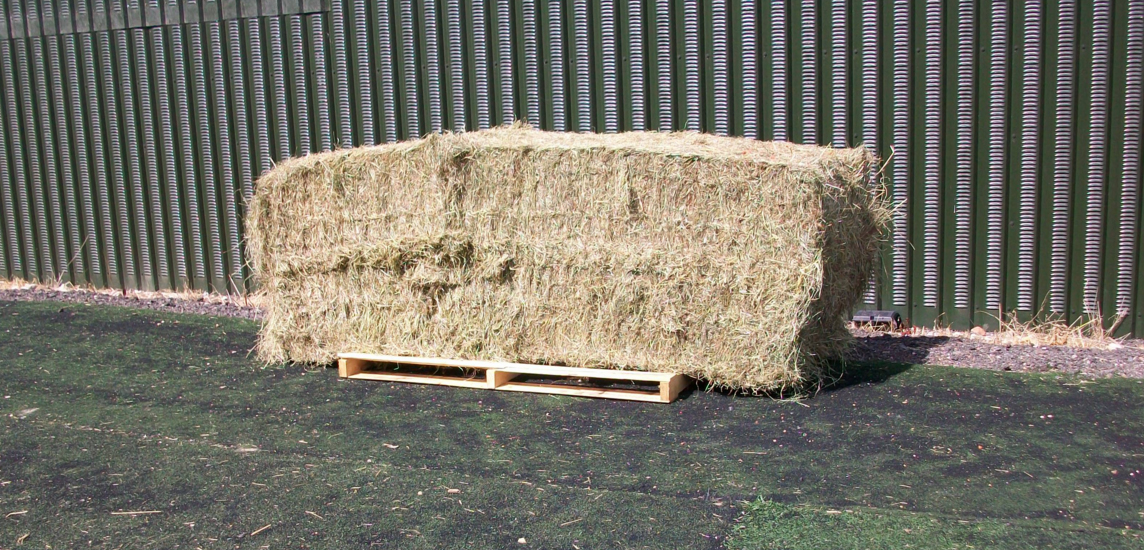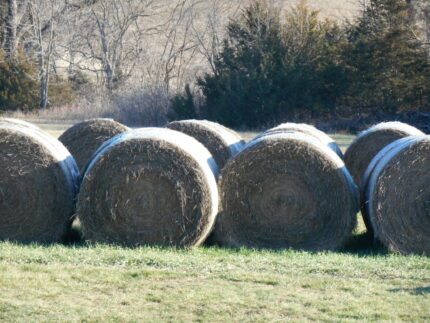Meadow Hay – Big Bales
Approx. 300kg bales, delivered in multiples of 3.
These bales measure approx. 8ft long.
Meadow hay, a staple in the diet of many herbivorous pets and livestock, is a type of grass hay harvested from natural grasslands or meadows. It’s renowned for its nutritional value, palatability, and suitability for a variety of animals, including rabbits, guinea pigs, chinchillas, and horses.
*Characteristics:*
– *Grass Varieties:* Meadow hay typically consists of a blend of various grass species such as timothy grass, orchard grass, brome grass, fescue, and ryegrass. These grasses contribute to its diverse nutrient profile and palatable taste.
– *Texture:* Meadow hay is characterized by its fine to medium texture, with strands that are soft and pliable. This makes it easy for animals to chew and digest.
– *Color:* The color of meadow hay can vary depending on factors such as the grass species present and the time of harvest. It ranges from a vibrant green when freshly cut to a golden yellow when dried.
– *Aroma:* High-quality meadow hay emits a fresh, sweet aroma reminiscent of freshly mown grass, which indicates its freshness and nutritional value.
*Nutritional Composition:*
– *Fiber:* Meadow hay is an excellent source of dietary fiber, essential for maintaining healthy digestion and preventing gastrointestinal issues in herbivorous animals. The long fibers promote natural chewing behavior, which helps wear down teeth and prevent dental problems.
– *Protein:* While not as high in protein as legume hays like alfalfa, meadow hay still provides a moderate amount of protein essential for muscle maintenance and growth.
– *Vitamins and Minerals:* Meadow hay contains essential vitamins and minerals such as vitamin A, vitamin D, calcium, and phosphorus, vital for overall health and well-being.
Benefits:
– Digestive Health: The high fiber content of meadow hay promotes healthy digestion by stimulating gut motility and preventing conditions like gastrointestinal stasis in rabbits and other small animals.
– Dental Health: Chewing on meadow hay helps wear down animals’ continuously growing teeth, preventing dental problems such as malocclusion and overgrowth.
– Enrichment: Meadow hay serves as an enriching addition to the diet, providing mental stimulation and encouraging natural foraging behaviors in pets like rabbits and guinea pigs.
– Hydration: While not a substitute for water, meadow hay can contribute to overall hydration levels in animals, especially when offered fresh and moist.
Harvesting and Processing:
– Meadow hay is typically harvested in the late spring or early summer when grasses are at their peak nutritional value and before they go to seed.
– After cutting, the grass is left to dry in the sun until it reaches the desired moisture content, usually around 10-15%.
– Once dried, the hay is baled and stored in a dry, well-ventilated area to maintain its quality and freshness.
Quality Considerations:
– Freshness: High-quality meadow hay should have a fresh, sweet aroma and vibrant green color. Avoid hay that appears dusty, musty, or moldy, as these can indicate poor quality and potential health risks for animals.
– Texture: Opt for meadow hay with a soft, pliable texture and long strands, which are easier for animals to chew and digest.
– Cleanliness: Ensure the hay is free from debris, weeds, and pests that may pose a health hazard to animals.
In summary, meadow hay is a nutritious and essential component of the diet for many herbivorous pets and livestock. Its rich fiber content, palatable taste, and diverse nutrient profile make it an ideal choice for promoting digestive health, dental wear, and overall well-being in animals. When selecting meadow hay, prioritize freshness, texture, and cleanliness to ensure the highest quality for your furry companions.















Reviews
There are no reviews yet.